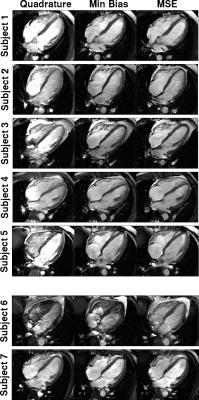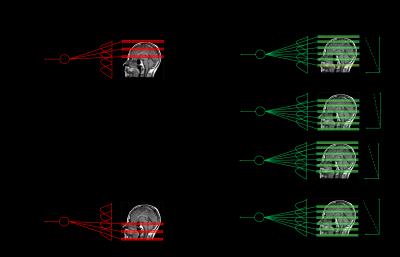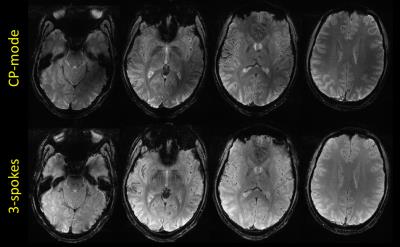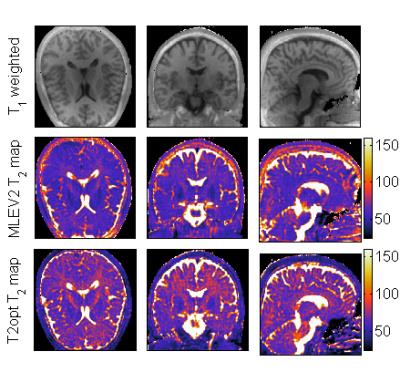Oral
Acquisition, Reconstruction & Analysis
Tuesday, 25 April 2017
| Room 312 |
08:15 - 10:15 |
Moderators: Priti Balchandani, Klaus Scheffler |
Slack Channel: #s_acq_recon_analysis
Session Number: O57
08:15
 |
0382.
 |
Extended RF shimming: Sequence level parallel transmission optimization applied to steady state free precession MRI of the heart 
Arian Beqiri, Anthony Price, Joseph Hajnal, Shaihan Malik
Balanced steady-state free precession (bSSFP) cardiac MRI benefits greatly from reduced repetition time (TR). Minimum TR is often limited by specific absorption rate (SAR) and hardware constraints. RF shimming can be used with parallel transmission (PTx) to work within such constraints, but direct minimization of TR is not straightforward since the constraints themselves vary as TR is reduced.We present an extended RF shimming framework in which PTx degrees of freedom are simultaneously optimised with pulse sequence properties. The result is minimum TR bSSFP sequences that operate at the SAR limits and within hardware constraints for 3T cardiac MRI.
|
08:27
|
0383.
 |
Multi-Contrast EPI for use as a Neuro MR Scout and Screening - permission withheld
Mathias Engström, Enrico Avventi, Ola Norbeck, Henric Rydén, Stefan Skare
This work describes a new sub-minute EPI-based sequence that produce T2*, T2, T2-FLAIR, T1-FLAIR, DWI, and ADC images as well as a 3-plane localizer as an alternative to the conventional scout, enabling a clinical screening at the beginning of the exam.
|
08:39
 |
0384.
 |
High resolution imaging by phase encoded xSPEN MRI 
Zhiyong Zhang, Michael Lustig, Lucio Frydman
We have recently introduced cross-term SPatiotemporal ENcoding (xSPEN), a technique with exceptional resilience to field heterogeneities. Like other single-shot methods, however, xSPEN’s resolution and SNR are intrinsically limited. This study explores a multi-scan, phase-encoded extension of xSPEN, which improves sensitivity while increasing resolution along both the phase-encoded and the slice-selection dimensions simultaneously. This reflects xSPEN’s unusual kernel whereby a y-axis can be sampled by a z-gradient and viceversa. Furthermore, as each phase-encoded xSPEN scan provides an entire 2D image, each low-resolution xSPEN scan in the set may be used to correct motions leading to very high definition 3D MRI capabilities.
|
08:51
 |
0385.
 |
Improved signal uniformity for balanced steady-state free precession by employing Direct Signal Control parallel transmission 
Francesco Padormo, Priti Balchandani
We present a method to minimize signal intensity variations observed when performing balanced steady state free precession imaging in non-uniform B0 and B1+ fields. This is achieved by harnessing parallel transmission, with RF shims calculated in order to produce the most uniform signal for the desired tissues given measured B0 and B1+ field maps.
|
09:03
 |
0386.
 |
Faster than Mulitband ... Advanced Pseudo Fourier Imaging's (API) response to the current state of the art 
Nishant Zachariah, Jason Langley, Justin Romberg, Xiaoping Hu
Multiband (MB) imaging is limited in its acceleration factor by the high correlation that exists between receiver coils. In this work, we present a novel technique, Advanced Pseudo Fourier Imaging (API) which achieves parallel excitation beyond that which is currently possible using multiband imaging. In doing so, API forms a generic framework for seamless transition from 2D to 3D imaging. Unlike MB, API is less sensitive to the RF excitation profile in its slice reconstruction by virtue of the introduced phase variations. We demonstrate the viability of API through 1D simulations and 3D head phantom data acquired at 3T.
|
09:15
|
0387.
 |
Whole Brain Inversion Recovery Diffusion Weighted Imaging Using Slice-Shuffled Acquisition 
Hua Wu, Qiyuan Tian, Christian Poetter, Kangrong Zhu, Matthew Middione, Adam Kerr, Jennifer McNab, Robert Dougherty
Combined acquisition of diffusion weighted MRI and T1 relaxation allows us to extract information about the microstructures of human brain on a sub-voxel level. We design an inversion recovery pulse sequence with diffusion weighting using the slice-shuffled technique to accelerate the T1 measurement and demonstrate whole brain scans acquired in under 20 minutes. We show potential applications of the sequence in differentiating the T1 relaxation of compartments with different diffusion properties within a voxel .
|
09:27
|
0388.
 |
Whole-brain multi-slice multi-spoke parallel transmit RF pulse design in the large flip angle regime at 7 Tesla 
Vincent Gras, Alexandre Vignaud, Alexis Amadon, Franck Mauconduit, Denis Le Bihan, Nicolas Boulant
At ultra-high field, transmit RF field inhomogeneity mitigation methods exploiting parallel transmission and multi-spoke pulses are readily applicable for brain imaging with small flip angle (FA) protocols. The extension to large FAs yet appears more challenging due to the inherent computationally extensive calculations. Dealing now with multi-slice applications, where specific absorption rate (SAR) issues often come into play, a SAR-aware slice-specific pulse design algorithm can improve significantly the output. This work thus presents a large FA slice-specific multi-spoke pulse design approach enforcing explicitely SAR constraints and, to reduce computations, where the spin dynamics is approximated with Average Hamiltonian Theory.
|
09:39
 |
0389.
 |
Velocity Encoded and Compensated Multi-Spoke RF Pulses for Flow Quantification at Ultra-High Fields 
Simon Schmidt, Sebastian Flassbeck, Mathies Breithaupt, Peter Bachert, Mark Ladd, Sebastian Schmitter
In this work we present and demonstrate a novel technique to generate multi-spoke RF excitation with arbitrary zeroth and first gradient moments, allowing for clean flow imaging without errors. The RF pulses are demonstrated in flow phantoms and in-vivo at 7 Tesla, paving the road for 4D flow imaging using pTX spoke excitation.
|
09:51
|
0390.
 |
A single-channel universal SPINS pulse for calibration-free homogeneous excitation without PTX 
Ronald Mooiweer, Joseph Hajnal, Shaihan Malik
A universal single-channel pulse was created that improves excitation homogeneity at 3T, for low flip angles. This method does not require subject specific calibration nor a PTX system, thus making it widely applicable. Though even better homogeneity could be achieved through the use of PTX or subject-specific pulse design, in our study the universal single-channel pulse always outperformed the quadrature mode excitation. This could be used to create more uniform contrast in MP-RAGE imaging.
|
10:03
|
0391.
 |
Optimal control B1-robust T2 preparation 
Martin Janich, Ana Beatriz Solana Sánchez, Florian Wiesinger
T2 is an important MR imaging contrast, including visualizing edema, myocarditis, separating coronary lumen from myocardium, as well as cerebrospinal fluid from gray and white matter. For diagnostic accuracy, it is important to achieve uniform T2-weighting throughout the imaging field-of-view. This is often not achievable because of non-uniform B1, especially at ultra-high magnetic field. This limitation was overcome by numerical optimization of a T2 preparation module. The optimal control T2 preparation pulse achieved good T2 contrast despite ±40% B1 variation and was scalable to achieve different T2 weighting times. Evaluation was done with Zero-TE imaging in the human brain at 3T.
|
|











